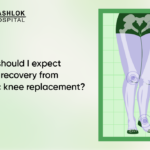The Advantages and Disadvantages of Robotic Knee Replacement: A Comprehensive Guide

One of the most revolutionary advancements in orthopaedic surgery is robotic knee replacement surgery, a game-changer for those suffering from severe knee pain. Whether you’re young or old, the increasing demand for knee replacements due to changing lifestyles and dietary habits has made it crucial to explore the advantages and disadvantages of robotic knee replacement before making a decision. At Aashlok Hospital, we are dedicated to providing effective robotic knee replacements to every age group, ensuring optimal recovery and long-term benefits for our patients. Our state-of-the-art robotic knee replacement technology offers unparalleled precision, faster recovery times, and enhanced patient outcomes.
So now, let’s explore the key pros and cons of robotic knee replacement surgery below.
Also Read : What should I expect during recovery from robotic knee replacement?
Table of Content
Introduction
Is Robotic Knee Replacement Surgery a New Technology?
Advantages of Robotic Knee Replacement
- Personalized Implant Positioning
- Real-Time Feedback and Adjustments
- Enhanced Precision and Accuracy
- Reduced Soft Tissue Dissection
- Improved Bone-Implant Integration
- Minimal Pain and Faster Recovery
- Suitability for Complex Joint Deformities
- Reduced Scarring
Potential Disadvantages and Risks Associated with Robotic Knee Replacements
Is Robotic Knee Replacement Surgery a New Technology?
Robotic-assisted surgery has gained significant popularity worldwide, mainly due to advancements in robotic systems in healthcare provinces. In the early 2010s, robotic knee replacement technology was refined through the integration of 3D modelling and robotic arms, which revamped precision. By 2016, the Mako Robotic System was recognized universally for its effectiveness in knee replacement surgeries, aided by personalized surgical plans. Since then, the technology has been evolving.
Robotic knee surgery was introduced in India in the mid-2010s, with leading hospitals adopting advanced robotic systems. We, at Aashlok Hospital, are renowned for our highly qualified orthopaedic surgeons who utilize systems such as Mako and Navio, certifying precision, durability, and accelerated recovery for our patients.
But the question lies is robotic knee replacement surgery better? Although conventional surgery has been effective in alleviating pain and restoring function, a conspicuous percentage of patients continue to express discontent due to persistent pain, limited range of motion, or an abnormal sensation in the knee. Therefore, it is crucial to consider the advantages and disadvantages of robotic knee replacement surgery and be cognizant of whether robotic knee surgery is better than traditional or not.
Also Read : All you need to know about – knee surgery
Advantages of Robotic Knee Replacement
There are several advantages and disadvantages of robotic knee replacement. Below we have highlighted some of the key pros of robotic knee replacement over traditional techniques:
1. Personalized Implant Positioning
Robotic systems augment personalised implant positioning by commissioning advanced 3D mapping technology that integrates preoperative CT scans and allows intra-operative adjustments. Orthopedic surgeons can make precise modifications to implant placement with submillimeter accuracy, a level of precision that is difficult to achieve with the human eye.
3D mapping technology assists orthopaedic surgeons in a variety of procedures:
- Assessing the knee joint to identify damaged zones and develop a surgical plan accordingly.
- Customising the surgery according to the patient’s unique anatomy to ensure an optimal fit for the implant.
- Conducting a virtual surgery beforehand to identify challenges and optimize the surgical approach accordingly.
At Aashlok Hospital, we use the Mako and Navio systems to guarantee precision and long-lasting results.
2. Real-Time Feedback and Adjustments
Among the many advantages and disadvantages of robotic knee replacement, one of the major benefits is its real-time feedback mechanism. Certain robotic systems incorporate real-time feedback, advanced imaging, and computer-assisted guidance, providing orthopaedic surgeons with immediate information on alignment and positioning. For example;
- MAKO Robotic System uses a robotic arm and real-time data to assist orthopaedic surgeons in performing both partial and total knee replacements with high precision.
- Navio Surgical System provides real-time feedback and does not require a preoperative CT scan. It uses advanced sensors to guide the orthopedic surgeon during the procedure, ensuring accurate implant placement.
- Velys Robotic-Assisted System integrates advanced imaging and real-time analytics to assist orthopaedic surgeons in achieving accurate alignment and balance during knee replacement procedures.
Also Read : Pain Management After Knee Replacement: Tips for Comfort
3. Enhanced Precision and Accuracy
Robotic systems enable more precise bone resection and implant placement than traditional methods. This amplified accuracy leads to improved limb alignment and a more ardor-feeling knee, essential for long-term durability.
The semi-active systems, also referred to as haptic or orthopedic surgeon-guided systems, employ a robotic arm as the fundamental for robotic knee replacement surgeries. This method guarantees that the incisions are precise and accurate, preventing the orthopaedic surgeon from drifting from the predetermined pre-operative plans, reducing human error and ensuring consistent results.
4. Reduced Soft Tissue Dissection
Several technologies are engineered to minimize soft tissue disruption during surgical procedures, maximizing the advantages and reducing the disadvantages of robotic knee replacement.
- ROSA uses a combination of preoperative imaging (like X-rays) and intraoperative data to plan and execute precise cuts, reducing unnecessary dissection of surrounding tissues.
- Soft Tissue Preservation system helps in assessing and balancing ligament tension throughout the surgery, minimizing soft tissue stress and dissection.
- CUVIS Joint Robot executes cuts with incredible accuracy, which reduces manual intervention and soft tissue injury surrounding the knee joint.
5. Improved Bone-Implant Integration
Enhanced alignment and a superior fit between the bone and implant decrease the risk of implant loosening over time, leading to increased durability and long-term success. Our orthopaedic surgeons employ some of the best-known innovations to ensure optimal results, such as:
- Implants with bioactive coatings like hydroxyapatite offer greater advantages than disadvantages in robotic knee replacement. They promote natural bone growth and integration. These coatings mimic the mineral composition of bone, encouraging the body to bond with the implant.
- Implants with porous metal surfaces, such as those made from titanium alloys, allow bone tissue to grow into the implant, creating a stable and long-lasting bond.
- Advanced Materials like oxidized zirconium and highly cross-linked polyethylene (HXLPE) are used for their durability and compatibility with bone tissue, reducing wear and improving integration.
- Emerging technologies include smart implants equipped with sensors to monitor bone integration and detect potential issues early.
Also Read : Best Exercises for Recovery After Knee Replacement Surgery
6. Minimal Pain and Faster Recovery
Robotic knee replacement surgeries are designed to minimize pain and accelerate recovery by using advanced technologies. Among the most effective systems for these outcomes are:
- Mako Robotic-Arm Assisted Surgery uses 3D imaging, leading to less pain, reduced swelling, and faster recovery due to the minimally invasive approach.
- ROSA Knee System Soft Tissue Preservation, CUVIS Joint Robot Fully Automated, and CORI Robotic-Assisted System are focused on balancing ligaments and minimizing soft tissue dissection, leading to quicker rehabilitation and less postoperative discomfort, and a more natural-feeling knee.
7. Suitability for Complex Joint Deformities
Robotic knee replacement surgery is highly efficient in treating various knee deformities in comparison to traditional knee replacement surgeries, making it a better choice for you.
| Deformity | Type of Robotic Knee Replacement Surgery |
| Severe Osteoarthritis | Robotic-Assisted Total Knee Replacement |
| Bowlegs (Varus Deformity) | Robotic-Assisted Total Knee Replacement with Navigation Technology |
| Knock Knees (Valgus Deformity) | Robotic-Assisted Total Knee Replacement with Customized Alignment |
| Flexion Contracture | Robotic-Assisted Total Knee Replacement to restore full knee extension |
| Post-Traumatic Arthritis | Customized Implants with Robotic Assistance |
| Severe Joint Misalignment | Robotic-Assisted Total Knee Replacement with Pre-Surgical 3D Simulation |
8. Reduced Scarring
The list of advantages and disadvantages of robotic knee replacement wouldn’t be complete without this factor. The smaller incisions made during robotic surgery result in minimal scarring, promoting a more aesthetically pleasing outcome, making it ideal for people employed in the domains of modelling and beauty. However, to reduce scarring effects drastically, post-care steps must be followed, such as;
- Keeping the incision site clean and dry.
- Massaging the scar once the incision is fully healed.
- Use the recommended ointments or creams suggested by your orthopaedic surgeons.
Potential Disadvantages and Risks Associated with Robotic Knee Replacements
Despite the potential benefits, robotic TKR also has some cons. So, among the many pros and cons of robotic knee replacement surgery, here are some of the potential disadvantages of the procedure.
Also Read : What to Expect from a Partial Knee Replacement Surgery?
1. High Costs of Procedure
The cost of robotic knee replacement surgery can vary depending on the system used, the hospital, and the location. Here are some general insights into cost-effective options:
- Navio Surgical System is often considered more affordable because it doesn’t require preoperative CT scans, reducing overall costs.
- CUVIS Joint Robot system is gaining popularity in India for offering advanced technology at a relatively lower cost compared to some other robotic systems.
- Traditional Minimally Invasive Techniques with Robotic Assistance is a hybrid approach that combines traditional methods with robotic assistance, which can be more affordable than fully robotic systems.
2. Not Ideal for Patients with Certain Medical Conditions
This treatment is not suitable for patients with certain medical conditions, such as;
- Active Local or Systemic Infections
- Severe Vascular or Nerve Disorders
- Unstable Medical Conditions like uncontrolled diabetes, severe heart disease etc.
- Severe Bone Loss
- Allergies to Implant Materials
A consultation with our expert orthopaedic surgeons can help you determine whether you’re a good candidate for robotic knee replacement or not.
3. Availability
Specific infrastructure requirements, such as advanced operating rooms and technical support, may not be feasible in all healthcare facilities.
Further, robotic surgical systems require regular maintenance and software updates, and reduced steep learning curves that add up to the availability issues.
Also Read : Knee Replacement Cost in India: How to Choose the Right Surgeon and Hospital
Conclusion
At the end of the day, whether robotic knee replacement surgery is the right choice depends on the individual patient. While the advantages and disadvantages of robotic knee replacement must be considered, it’s clear that this technology provides superior precision, reduced pain, and a faster return to mobility.
If you’re still wondering, “is robotic knee replacement surgery better,” the answer is clear: for many patients, yes. With state-of-the-art robotic systems, experienced orthopedic surgeons, and a commitment to excellence, Aashlok Hospital ensures that every patient receives the best possible care, maximizing their mobility and quality of life.
FAQs
What are the main advantages of robotic knee replacement?
Robotic knee replacement is an evolving technology that offers numerous benefits, such as pre-operative planning, robotic arm-assisted surgery, real-time adjustments, and guiding haptic technology, leading to reduced tissue damage, less pain, and faster recovery.
Are there any disadvantages of robotic knee replacement surgery?
Besides the cost factor, robotic knee replacement surgery is not widely available due to management issues and is not ideal for patients with certain medical conditions.
How is robotic knee replacement different to traditional knee replacement?
Traditional knee replacement surgery relies on standard surgical instruments and measurements made during the operation whereas robotic knee replacement surgery offers 3D imaging of the knee joints, real-time feedback and sensory guidance allowing orthopaedic surgeons to plan the procedure with great detail and minimal invasive approach which leads to better alignment, reduced scarring, speed up recovery and extended implant life.
What is the success rate of robotic knee replacement surgery?
Robotic knee replacement surgery has demonstrated encouraging success rates, frequently surpassing 90% in patient satisfaction and enhanced joint function.











